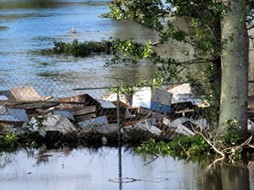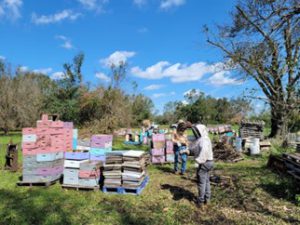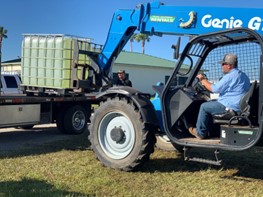Florida bee colonies that were destroyed by Hurricane Ian are smashed, drowned and starving
| By Kerry Sheridan

Keith Councell Beehives lay in a shambles in floodwaters in Arcadia, a rural area in DeSoto County which saw high floodwaters after Hurricane Ian.
Experts say the number of bee colonies in the path of the Category 4 hurricane account for about 1 in 7 of the nation’s total. They represent a crucial pollination force.
Keith Councell raises bees for a living. His hives span a 50-mile stretch from the coastal areas near Fort Myers to rural areas in central Florida. He says Hurricane Ian took aim at all of them.
“It literally followed the line of my farms. So from Pine Island, all the way up through here in Arcadia,” Councell said.
Still unable to check on all of his bee yards due to floodwater and hazardous conditions two weeks after the storm, Councell said some hives were destroyed when trees fell on them. Others look like they were torn apart by tornadoes.
“The winds blew the lids off, exposed the bees. Some of those winds actually sucked the bees, the frames out of our boxes. And then we had the flood that came through, and that drowned them,” said Councell, who is also chair of the Florida Farm Bureau Apiculture Committee.

Courtesy Keith Councell One of Keith Councell’s bee yards as workers clean up after the storm, picking up and stacking dead hives
Councell and more than a dozen other beekeepers gathered to pick donations of corn syrup Saturday at the Turner Agri-Civic Center in Arcadia, a small rural town known for its rodeo, and where high flood waters still hug the roadsides.
Some 380,000 registered Florida bee colonies were in the path of Ian, according to the University of Florida. Researchers are still calculating how many were destroyed.
The storm hit at a critical time in the farming cycle, just as many beekeepers from the East Coast had brought their honey bees to Florida to pollinate Brazilian pepper trees, make a honey popular with bakers, and build up their numbers for the winter crops out west.
“I been through Charley, Irma and quite a few other little freak storms. But I’m telling you this is the worst I’ve seen,” said beekeeper Robert Hill. “I’ve got 250 colonies and I’m not even sure how many I’ve got alive right now.”
 Totes containing 250 gallons each of syrup were donated to the beekeepers. Keith Councell said beekeepers are grateful, but “this is just a tiny rain drop in the ocean of what’s needed.”
Totes containing 250 gallons each of syrup were donated to the beekeepers. Keith Councell said beekeepers are grateful, but “this is just a tiny rain drop in the ocean of what’s needed.”
“It’s a mess. And I’m not even sure if there is going to be any help for us, because I’ve been calling a few pieces to see — I have called the Agriculture Department. And it’s from one thing to another. So we’re not even sure what’s going to take place yet. We just live in limbo. We’re going to need some help, definitely to get out of this crisis.”
As Hill spoke and shared stories with other beekeepers, a forklift moved big plastic cubes, called totes, containing 250 gallons of syrup each. The sugar syrup was donated by the Greater Good to help feed the bees that survived.
Beekeeper Erick Peterson said Ian’s 150-mile-per-hour winds blew the blossoms off the trees and wiped out so much vegetation that the bees can’t find food to forage.
“They’re starving,” said Peterson, who plans to divide the syrup into one-gallon buckets to provide a temporary food source for each surviving colony.
“I have holes in the top of my lids of the hives and I just turn the buckets upside down on top and they draw it out and and feed themselves,” Peterson said.
The aftermath of the storm sparked a kind of war among the surviving bees. Now they are stealing honey from each other.
“I’ve got to stop the robbing, because I’ve got robbing going on,” said beekeeper Demetrius Washington.
“They are taking the honey from other hives.”
He hopes the syrup will help stop this, because robbing can kill what’s left of a colony.
Beekeeper Mark Negley said he lost 10% of his bees in Hurricane Charley in 2004. This time he suspects it is more like 30%.
“Especially on Pine Island where we had the storm surge,” said Negley. “I don’t know if anything is left at all, or they floated to half a mile away from somewhere and mangrove swamp never to be found again? Hopefully, the pallets are there, because those are really expensive to build.”
Amy Vu, the state specialized program extension agent for the University of Florida, said the U.S. Department of Agriculture provides some financial help after a storm, but donations like this bridge the gap for needs the beekeepers have now.
“Sometimes, some of the funding agencies take a little bit of time,” said Vu. “There is some USDA assistance. There is some assistance for beekeepers who already have insurance. There’s also a program called the ELAP. And that is also through the government where beekeepers can report losses,” she said.
“It’s really important for the beekeepers to document all of their losses and everything that’s happening on the field. If they’re not able to go to the apiary, they do as best they can to document everything.”
Fewer pollinators could mean smaller harvests, and higher prices at the grocery store. Councell says it could take beekeepers years to get back to where they were before Ian.
“All the beekeepers from the eastern United States are here. We’re down here trying to build up for pollination for the rest of the whole year and all the other crops — cherries, peaches, nectarines, plums, all the nut trees — all those have to be pollinated, our watermelon, squash, zucchini, all that,” said Councell.
Farmers out west are already asking if he can supply them bees by January, to pollinate the avocado and almond trees. He has told them yes, with the hope that he can.
“It’s a race right now to get the pillars of agriculture back up and running, to get the rest of agriculture rolling, so we can put the food on the table for people,” said Councell.
As beekeepers make plans to grow new colonies as fast as they can, The Florida State Beekepers Association has set up a GoFundMe account to raise $500,000 for the 1,500 affected beekeepers.
People who want to help can also grow plants that bloom and produce nectar, ranging from mint and basil, to sunflowers, marigolds and more.
We are here to share current happenings in the bee industry. Bee Culture gathers and shares articles published by outside sources. For more information about this specific article, please visit the original publish source: Florida bee colonies destroyed by Ian are smashed, drowned and starving | WUSF Public Media








